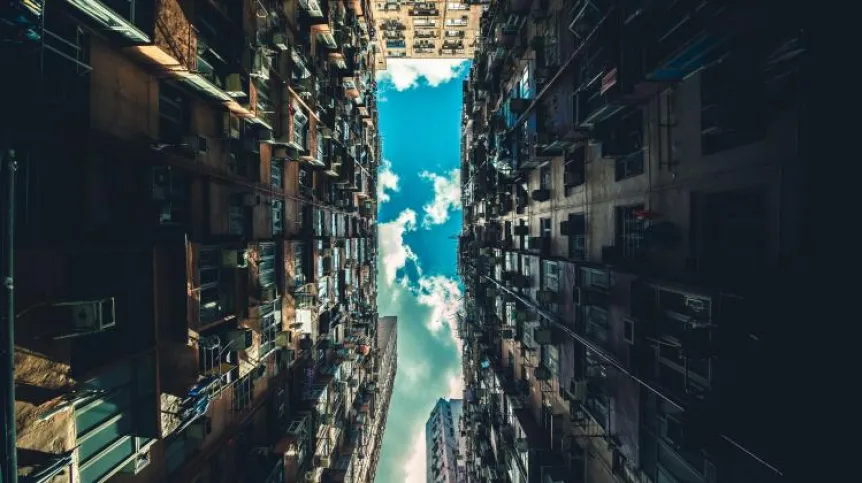
We are too dependent on artificial lighting, which negatively affects our mental and physical health, warns architect Dr. Karolina Zielińska-Dąbkowska from the Gdańsk University of Technology. According to the expert, when expanding cities, provisions that guarantee access to daylight should be introduced.
"The human body is evolutionarily adapted to bright day and dark night" - emphasises Dr. Karolina Zielińska-Dąbkowska, researcher and light architect from the Gdańsk University of Technology, whose expert articles on limiting access to natural light in contemporary cities and the harmful influence of artificial LED light on people appeared in the prestigious journal Nature - here and here.
The expert explains that natural light changes during the day in terms of intensity, angle and the colour of its spectrum. The changes taking place in visible light are closely related to our circadian rhythm and stimulate many biochemical processes in our bodies.
In natural morning light there is a lot of blue light, which stimulates the production of cortisol - a hormone that stimulates our activity. In the evening, there is little blue light in the spectrum of visible light, and red light prevails, which triggers the production of melatonin - a hormone that allows you to fall asleep.
"The morning light naturally stimulates us, and the evening light of the setting sun prepares us to sleep - we have been functioning this way for millennia" - notes Dr. Zielińska-Dąbkowska.
With the advent of the age of electricity, our lifestyle changed: the use of artificial light allowed to extend the hours of our activity until late at night, moving people away from the natural day/night cycle. "But contemporary artificial lighting creates additional, serious problems" - the expert warns.
This concerns LED lamps whose operation is based on light-emitting diodes. They have been introduced as an energy-saving alternative to traditional tungsten bulbs. Today, LED lamps account for the vast majority of artificial lighting available in stores.
"The problem with white LEDs is that they are blue LEDs covered with a phosphor layer" - explains Dr. Zielińska-Dąbkowska. "Although it appears that we see white light, when we use them in the evening, the brain receives information that the light is blue, a day has come and you should be active" - she adds.
The architect emphasises that traditional light sources are neutral for our biological clock, because the spectrum they emit corresponds to the light of the setting sun.
"When using LEDs in the evening or at night, we do not realize that this type of artificial light stimulates us, impairs sleep and disrupts the circadian rhythm, which affects not only sleep and waking cycles, but also food patterns, metabolism, reproduction, blood pressure and heart rate, hormone production, body temperature, mood, and even our immune system" - explains Dr. Zielińska-Dąbkowska.
She adds that scientific research shows that night is the most important period for the regeneration of our DNA and the natural removal of viruses, bacteria as well as daily produced cancer cells. "Anti-cancer cells are activated by a high level of melatonin in the blood in the dark. For this reason, the World Health Organization has already recognized the circadian disorder associated with contemporary artificial lighting as a potentially carcinogenic factor for people working in shifts" - she says.
"Experts are also aware that the knowledge about the effects of light on our organism is still very fragmentary" - notes Dr. Zielińska-Dąbkowska. She explains that an example of this can be the group of intrinsically photosensitive retinal ganglion cells (ipRGCs) discovered in the beginning of the 21st century.
"We still do not exactly know how our bodies are affected by long-term exposure to artificial lighting, and yet we are already trying to replace daylight with it" - the expert warns. She emphasises that many scientific studies on these issues still have to be carried out. "However, it is optimistic that producers of artificial LED lights are beginning to slowly understand the health risks and the need for such research" - she believes.
Meanwhile, artificial lighting is not the only problem, there are also contemporary urban and architectural trends. Access to natural light is also limited by ever taller buildings in cities. Architecture is climbing up and becoming more and more crowded. "This also applies to Polish cities" - noted Dr. Zielińska-Dąbkowska. "Although in Poland there are not as many high-rise buildings as in the US or Asia yet, every free space is used for development, especially in city centres. We have long abandoned pre-war standards, according to which one building should not obscure another" - she adds.
The increasing height of buildings also means difficulties in the production of so-called clean energy: tall buildings standing next to each other throw shade at photovoltaic panels. "Smaller access to natural light is not only a problem for people. Trees that do not receive enough light can not grow quickly. If tree do not grow, there is not enough photosynthesis. Without the photosynthesis process, the air in the cities does not get cleaned. It is one big, complicated chain of connections" - the expert says.
As part of the fight against the problem of darkening cities, Dr. Zielińska-Dąbkowska postulates that urban development plans should include a guarantee of access to daylight.
"The point is that, for example, there should be a certain number of square meters of green areas, such as a park, per each person living in a given place. Thanks to this, despite the increasing density of buildings, we could save valuable public spaces between buildings" - she explains.
The Gdańsk architect also proposes that both architects and urban planners should be required to observe specific standards. These standards should be developed by interdisciplinary expert teams composed of urban planners, building architects, engineers, landscape architects, as well as light architects, neuroscientists, doctors and other specialists.
PAP - Science in Poland, Katarzyna Florencka
kflo/ ekr/ kap/
tr. RL













